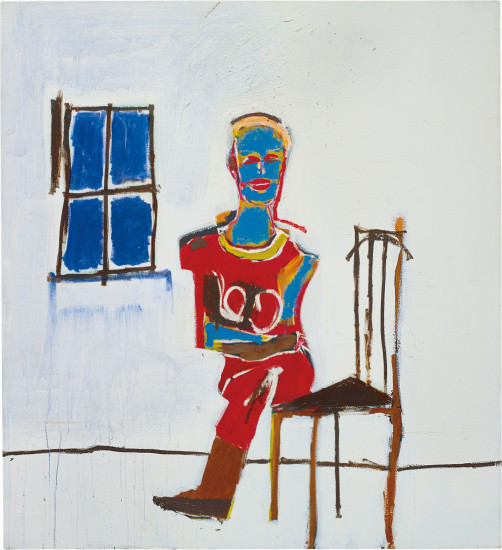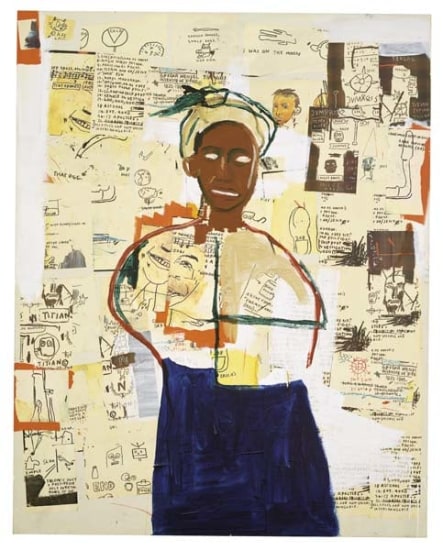22 Jean-Michel-Basquiat Untitled 1981 acrylic, oil stick, pencil, spray paint, paper collage on wood 48 x 30 x 1 1/2 in. (122 x 76.2 x 4 cm.) Signed, dated and inscribed "NYC 81 Jean-Michel-Basquiat" on the reverse.
Provenance Stavros Merjos, Los Angeles Neal Meltzer Fine Art, New York Literature R. D. Marshall and J-L. Prat, Jean-Michel-Basquiat, Paris, Galerie Enrico Navarra, New York, 1996, vol. II, p.58, no 4 (illustrated) Tony Shafrazi Gallery, Basquiat, New York, 1999, p. 65 (illustrated) R. D. Marshall and J.L. Prat, eds., Jean-Michel-Basquiat, Galerie Enrico Navarra, Paris: 2000, p. 88, no. 5, (illustrated) Catalogue Essay “My subject matters are royalty, heroism, and the streets.” JEAN-MICHEL-BASQUIAT, 1985 Jean-Michel-Basquiat’s prolific paintings of African American athletes and cultural heroes are among the most personally and politically charged works in his ephemeral yet vast oeuvre. In the figure of Jackie Robinson, Basquiat recognized a resilient hero and a captivating icon of self-made success. Robinson was an athletic champion who managed to triumph against all odds in the form of deep-rooted racial prejudices of the 1950s. This was a heroic figure that Basquiat truly identified with, growing up as a young man of Haitian and Puerto Rican heritage with incomparable artistic talent, challenging the predominantly white world of the competitive art scene. The present lot, Untitled, 1981, is one of Basquiat’s first images of the famed ball player, and one that predates most of his “famous negro athletes”; it is also a metaphorical self-portrait of Basquiat as a defiant competitor of his day. Basquiat defined his artistic subjects as “royalty, heroism, and the streets,” and the human figure quickly emerged as the central theme in Basquiat’s work, employed as a platform for combining autobiography with black history and popular culture. He had been aware of art history since his youth, visiting the Brooklyn Museum of Art near his home in the New York City borough. “I realized that I didn’t see many paintings with black people in them,” he remarked, and that “the black person is the protagonist in most of my paintings” (H. Geldzahler, “Art: From the Subways to Soho, Jean-Michel-Basquiat,” Interview, January 1983). Yet while he commemorated icons such as jazz luminary Charlie Parker and boxing champion Joe Louis later in his career, it was the context of Jackie Robinson within the world of baseball that made it the most attractive and urgent of his early subjects. The present lot combines a series of powerful images and events that Basquiat highly valued. There is, of course, the breakthrough black athlete in the figure of Jackie Robinson, but baseball, and it’s heroic stature as an American pastime and ritual, provides an equal amount of visual inspiration for Basquiat. As a mixed Puerto- Rican/Haitian who was also a first-generation American, Basquiat had three separate cultural influences that drove him toward the admiration of baseball as a cherished custom. In addition, baseball provides a remarkably fertile ground for the exploration of Basquiat’s themes: as the figure stands alone at bat, he has an equal amount of support and faction within the stadium, and he alone can write the destiny of his success. As a figure of adulation, the lone batter is the paradigmatic Basquiat overreacher— he who makes greatness for himself in the face of massive opposition. Combined with Robinson’s singular importance as a racial icon, the present lot sets the stage for Basquiat’s Famous Negro Athletes in a formative capacity, readying the batter’s box for the deluge of tributes to come. The present lot depicts the legendary Robinson in all his glory, worshiped by Basquiat’s own form of haloed, winged angels collaged below. Here, Basquiat also depicts his iconic sense of anatomical drawing, a mainstay of his early work. As the school of angels accepts Robinson into sainthood, winged arms up in praise for the revolutionary baseball, he has achieved the ultimate adulation. Additionally, Basquiat’s inclusion of crowns surrounding the figure symbolizes him as a monarch of sorts, a king of his craft; also, however, we see at play Basquiat’s admira
22 Jean-Michel-Basquiat Untitled 1981 acrylic, oil stick, pencil, spray paint, paper collage on wood 48 x 30 x 1 1/2 in. (122 x 76.2 x 4 cm.) Signed, dated and inscribed "NYC 81 Jean-Michel-Basquiat" on the reverse.
Provenance Stavros Merjos, Los Angeles Neal Meltzer Fine Art, New York Literature R. D. Marshall and J-L. Prat, Jean-Michel-Basquiat, Paris, Galerie Enrico Navarra, New York, 1996, vol. II, p.58, no 4 (illustrated) Tony Shafrazi Gallery, Basquiat, New York, 1999, p. 65 (illustrated) R. D. Marshall and J.L. Prat, eds., Jean-Michel-Basquiat, Galerie Enrico Navarra, Paris: 2000, p. 88, no. 5, (illustrated) Catalogue Essay “My subject matters are royalty, heroism, and the streets.” JEAN-MICHEL-BASQUIAT, 1985 Jean-Michel-Basquiat’s prolific paintings of African American athletes and cultural heroes are among the most personally and politically charged works in his ephemeral yet vast oeuvre. In the figure of Jackie Robinson, Basquiat recognized a resilient hero and a captivating icon of self-made success. Robinson was an athletic champion who managed to triumph against all odds in the form of deep-rooted racial prejudices of the 1950s. This was a heroic figure that Basquiat truly identified with, growing up as a young man of Haitian and Puerto Rican heritage with incomparable artistic talent, challenging the predominantly white world of the competitive art scene. The present lot, Untitled, 1981, is one of Basquiat’s first images of the famed ball player, and one that predates most of his “famous negro athletes”; it is also a metaphorical self-portrait of Basquiat as a defiant competitor of his day. Basquiat defined his artistic subjects as “royalty, heroism, and the streets,” and the human figure quickly emerged as the central theme in Basquiat’s work, employed as a platform for combining autobiography with black history and popular culture. He had been aware of art history since his youth, visiting the Brooklyn Museum of Art near his home in the New York City borough. “I realized that I didn’t see many paintings with black people in them,” he remarked, and that “the black person is the protagonist in most of my paintings” (H. Geldzahler, “Art: From the Subways to Soho, Jean-Michel-Basquiat,” Interview, January 1983). Yet while he commemorated icons such as jazz luminary Charlie Parker and boxing champion Joe Louis later in his career, it was the context of Jackie Robinson within the world of baseball that made it the most attractive and urgent of his early subjects. The present lot combines a series of powerful images and events that Basquiat highly valued. There is, of course, the breakthrough black athlete in the figure of Jackie Robinson, but baseball, and it’s heroic stature as an American pastime and ritual, provides an equal amount of visual inspiration for Basquiat. As a mixed Puerto- Rican/Haitian who was also a first-generation American, Basquiat had three separate cultural influences that drove him toward the admiration of baseball as a cherished custom. In addition, baseball provides a remarkably fertile ground for the exploration of Basquiat’s themes: as the figure stands alone at bat, he has an equal amount of support and faction within the stadium, and he alone can write the destiny of his success. As a figure of adulation, the lone batter is the paradigmatic Basquiat overreacher— he who makes greatness for himself in the face of massive opposition. Combined with Robinson’s singular importance as a racial icon, the present lot sets the stage for Basquiat’s Famous Negro Athletes in a formative capacity, readying the batter’s box for the deluge of tributes to come. The present lot depicts the legendary Robinson in all his glory, worshiped by Basquiat’s own form of haloed, winged angels collaged below. Here, Basquiat also depicts his iconic sense of anatomical drawing, a mainstay of his early work. As the school of angels accepts Robinson into sainthood, winged arms up in praise for the revolutionary baseball, he has achieved the ultimate adulation. Additionally, Basquiat’s inclusion of crowns surrounding the figure symbolizes him as a monarch of sorts, a king of his craft; also, however, we see at play Basquiat’s admira

.jpg)









Testen Sie LotSearch und seine Premium-Features 7 Tage - ohne Kosten!
Lassen Sie sich automatisch über neue Objekte in kommenden Auktionen benachrichtigen.
Suchauftrag anlegen